Serene interiors have surged in popularity as homeowners seek daily refuge from an overstimulated world. Drawing on Japanese aesthetics, mindfulness principles, and 2025’s broader “neutral-nature” trend, Zen rooms emphasize simplicity, sensory balance, and a strong link to the outdoors. The twenty-five concepts below each describe a complete, self-contained design theme — covering layout, palette, materials, lighting, and signature décor — so you can choose the atmosphere that resonates most deeply.
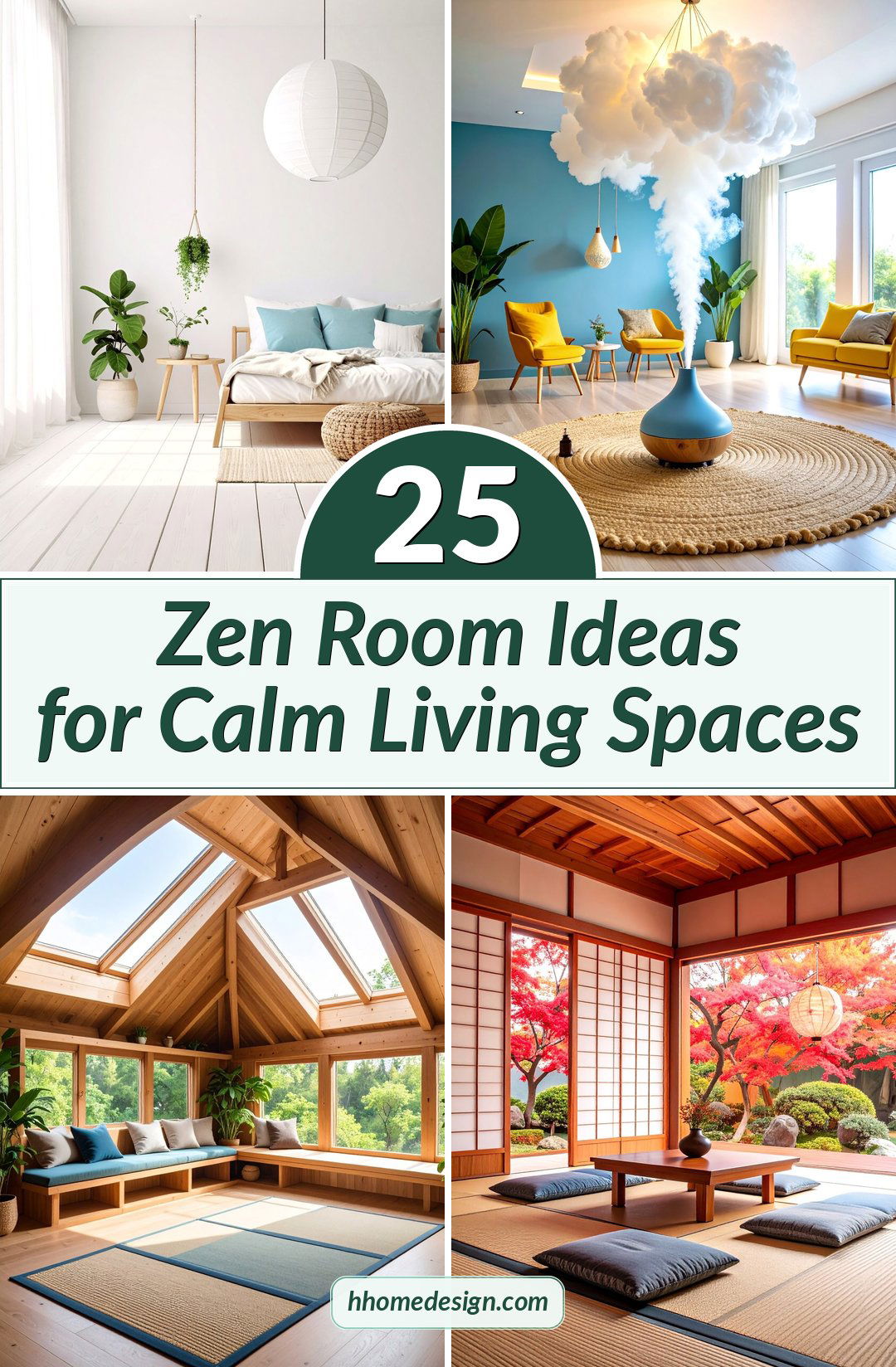
1. Neutral-Toned Minimalist Zen Room Sanctuary
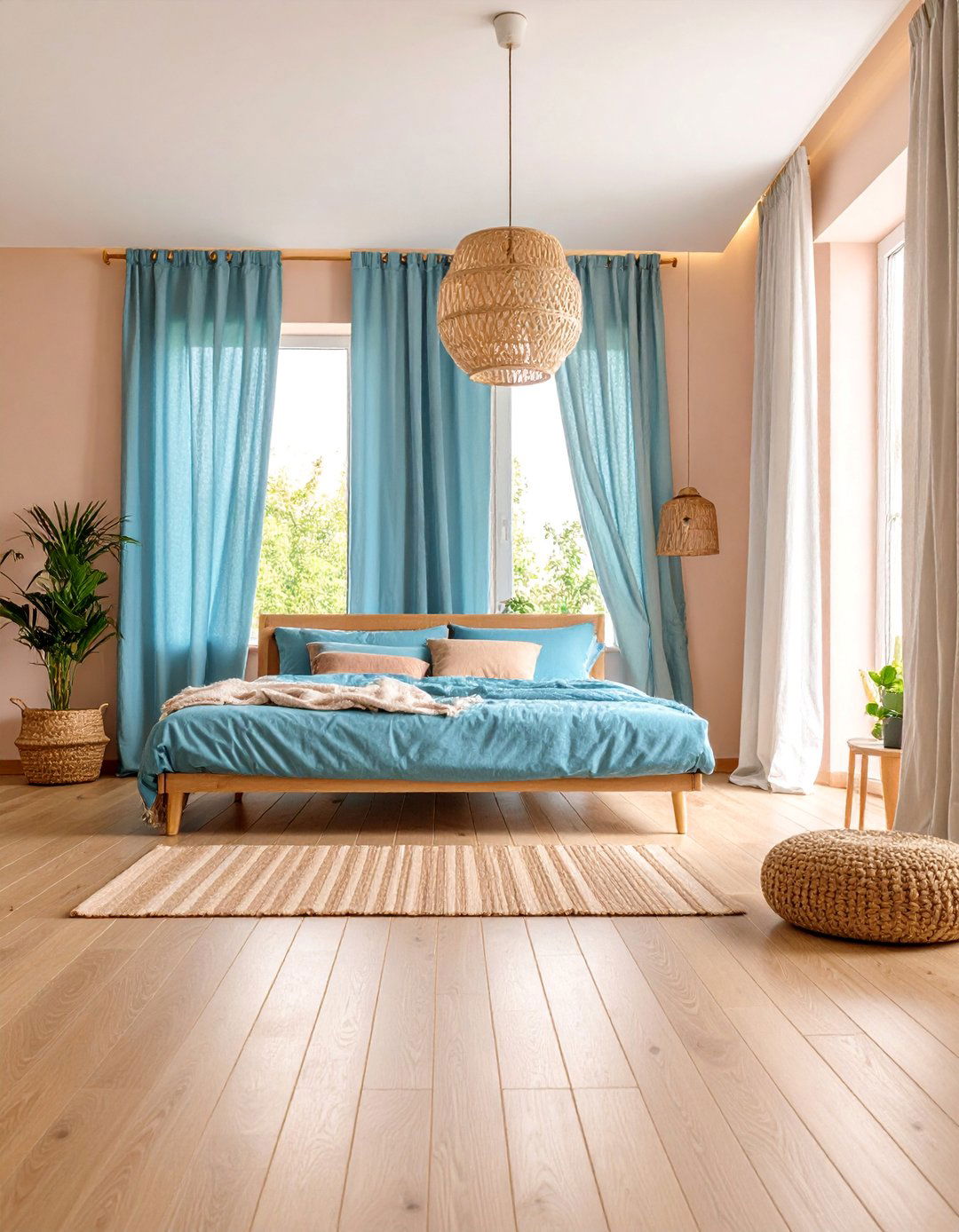
A calming sanctuary begins with warm white walls, pale oak flooring, and almost invisible built-in storage that reduces visual noise. Select a single low futon bed, cotton gauze curtains, and a natural-fiber area rug that frames a simple meditation cushion. Concealed LED coves wash the perimeter in soft light while a single potted ZZ plant adds organic shape without clutter. Encourage airiness by leaving one full wall unadorned; the negative space invites mindfulness. Finish with a discreet linen-wrapped diffuser releasing sandalwood, reinforcing the room’s sensory harmony and signaling it is time to slow the breath.
2. Tatami Platform Zen Room with Shoji Screens
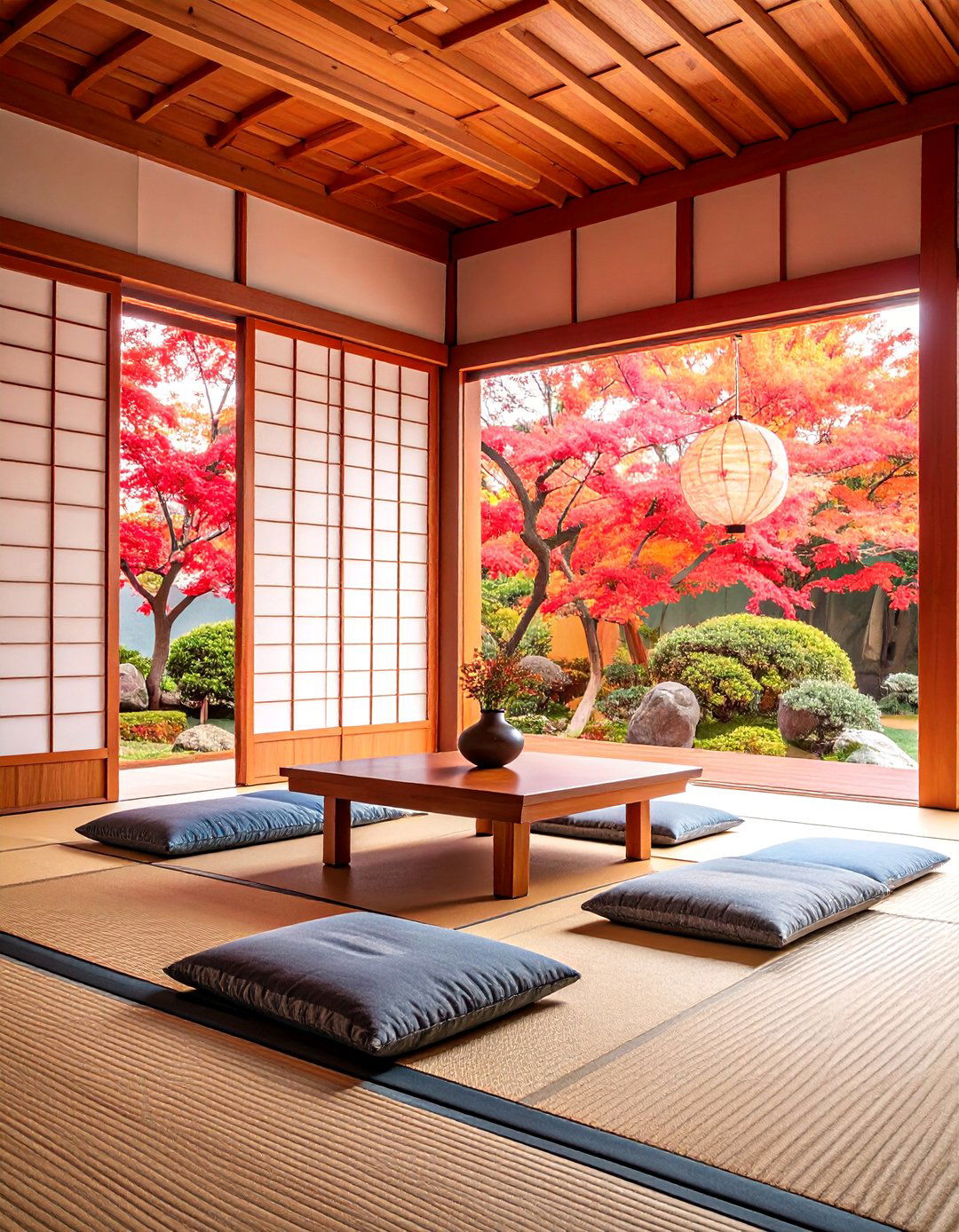
In this layout, traditional tatami mats cover an elevated plywood platform that defines the seating and sleeping zone. Sliding shoji screens replace conventional doors, filtering daylight into diffuse, paper-soft illumination. A low hinoki-wood table anchors tea or journaling rituals, supported by flat floor cushions stored under the platform drawers. Keep decoration to a single ikebana arrangement displayed on a built-in alcove shelf called a tokonoma. Neutral taupe walls and a rice-straw ceiling panel complete the immersive Japanese atmosphere while subtly insulating sound. The overall effect evokes a ryokan guest suite — tranquil, tactile, and timeless.
3. Indoor Zen Rock Garden Meditation Room
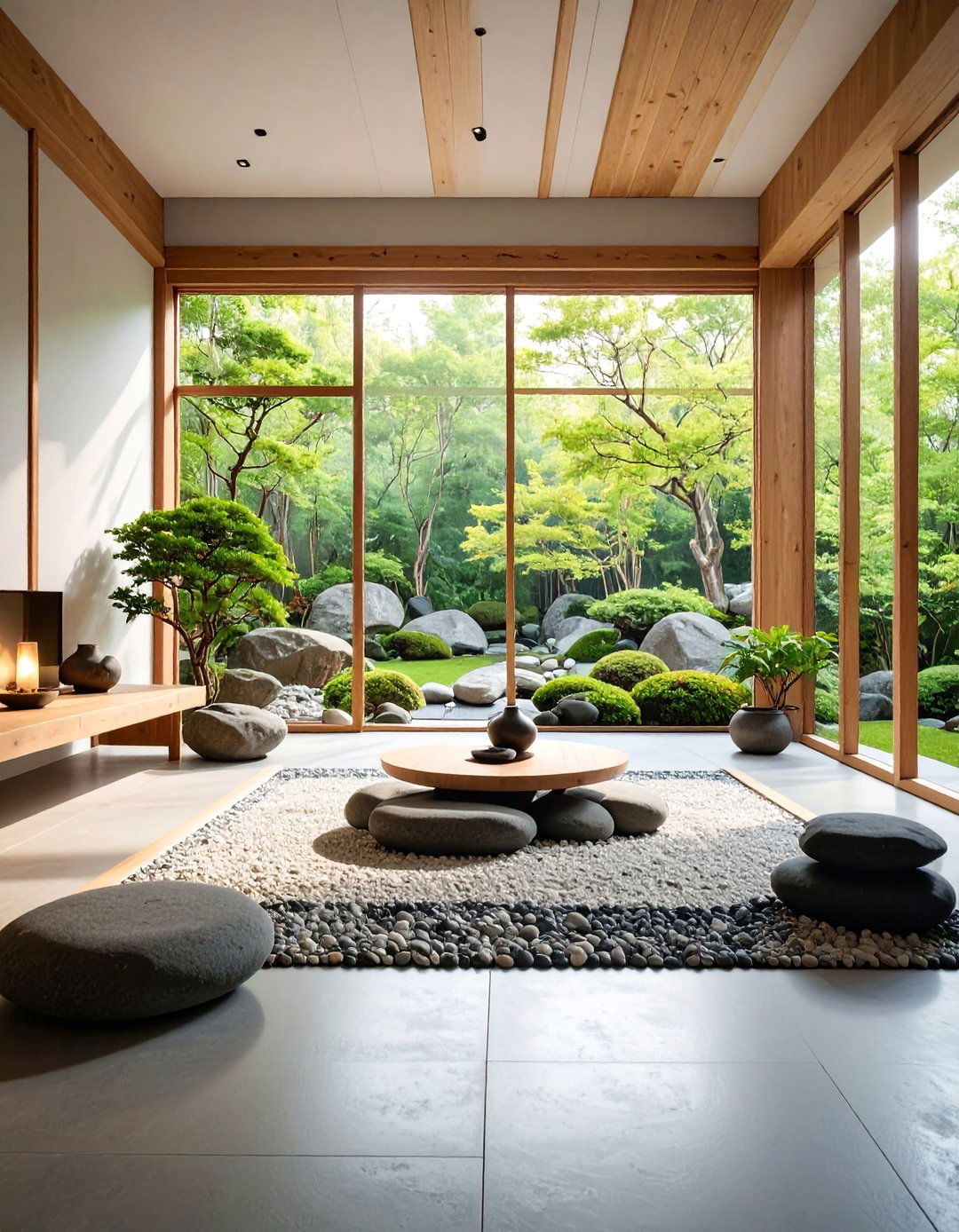
Unlike typical living rooms, this design devotes half the floor to a shallow rock garden bordered by a cedar frame. Raked white gravel surrounds three basalt stones, creating a kinetic canvas you can re-pattern daily for mindful practice. The remaining concrete floor hosts a single zafu and zabuton set beside a floating walnut shelf holding incense and a miniature bell. Up-lighting hidden in the garden’s perimeter casts dramatic shadows across the stones at dusk. A charcoal accent wall receives no artwork, ensuring the eye rests on texture and negative space rather than busy visuals.
4. Bamboo-Filled Zen Room with Living Green Wall
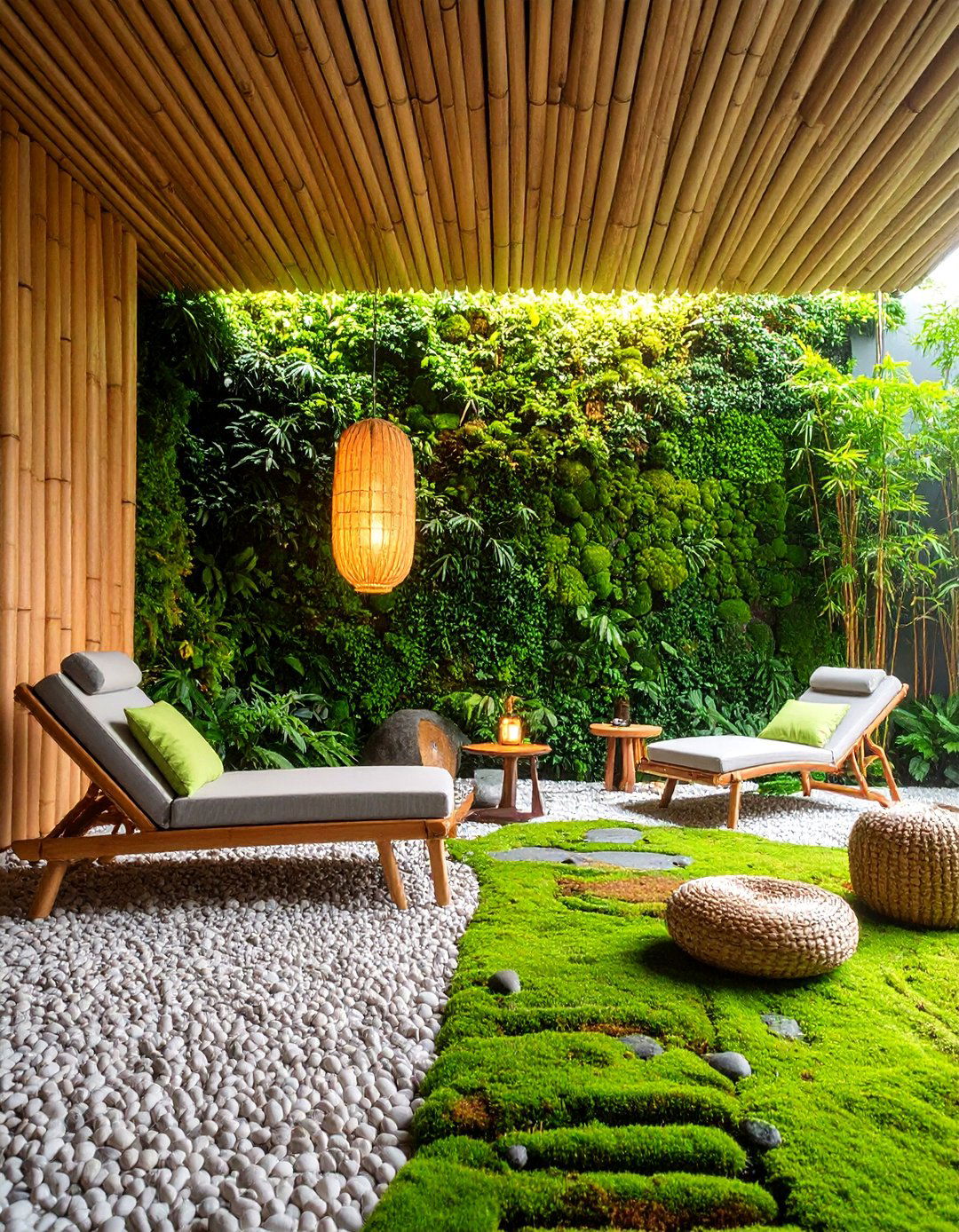
Surprisingly lush, this theme invites nature indoors through a hydroponic bamboo grove lining one side and a living moss wall opposite. Pale gray micro-cement floors and recessed ceiling panels let greenery dominate. A curved rattan chaise provides meditative lounging, while pebble beds hide indirect floor lighting that glows upward through bamboo culms at night. A white noise fountain disguised as a smooth river stone sits in the corner, masking urban sounds. Aroma diffusers emit fresh lemongrass, reinforcing the verdant ambience and promoting respiratory ease with every breath.
5. Japandi Style Zen Room with Low Furnishings
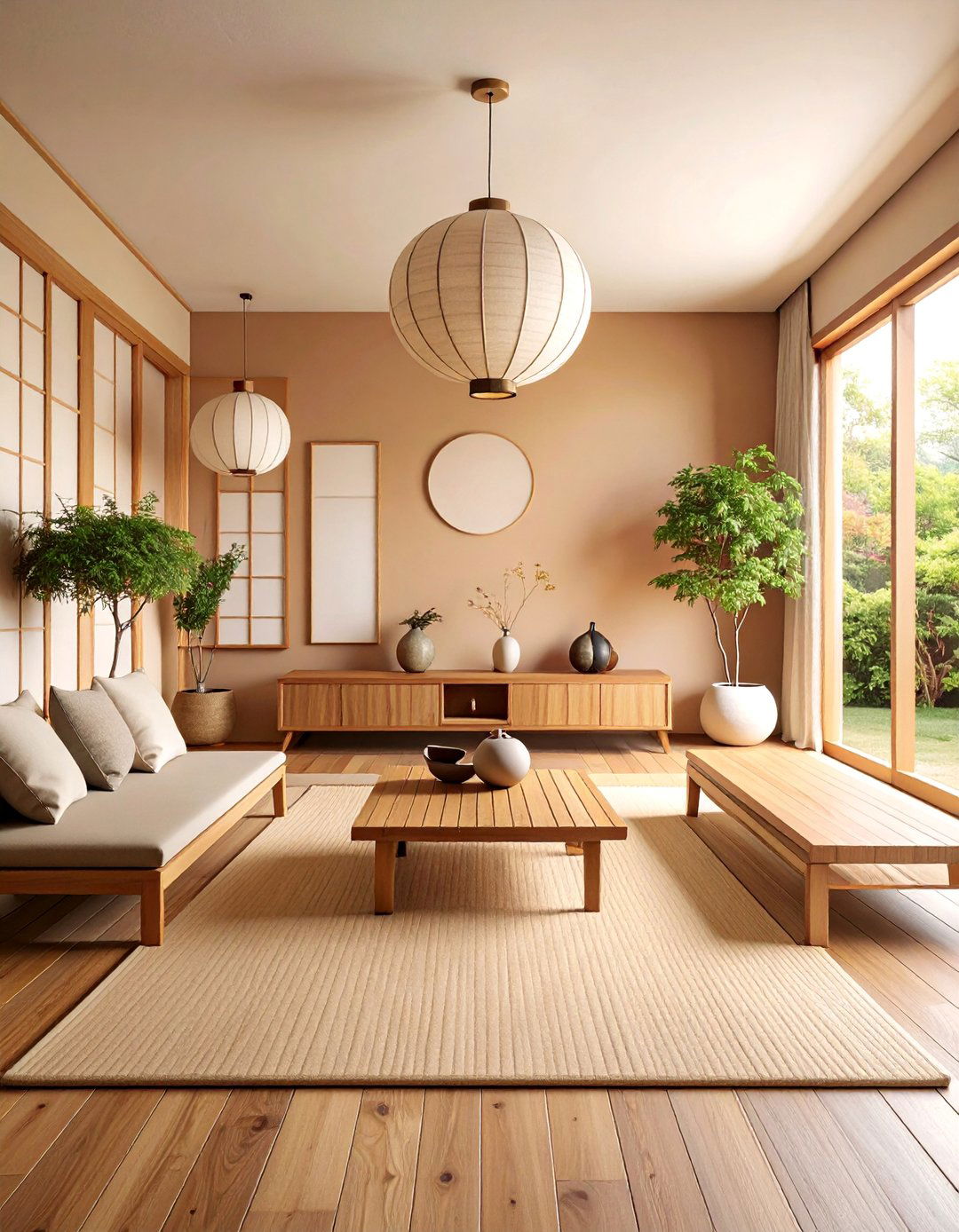
Blending Scandinavian utility with Japanese restraint, this Japandi concept features low, wide oak benches doubling as seating and display. Muted clay-beige walls meet matte-black window frames for subtle contrast. Soft wool throws and linen cushions keep the palette earthy yet comfortable. Paper lantern pendants hang asymmetrically over a natural ash coffee table, while minimal pottery pieces echo wabi-sabi imperfection. Clutter stays hidden inside push-latch cabinets recessed into walls, leaving surfaces visually calm. The result feels both cozy and disciplined — perfect for quiet reading or mindful conversation.
6. Zen Room Tea Ceremony Nook

For tea lovers, dedicate a compact alcove to a formal cha-no-yu experience. Cork flooring cushions knees, and a sunken hearth hosts a cast-iron kettle. Wall niches display matcha bowls and bamboo whisks like functional art. Lighting comes from a single washi-paper lantern suspended low over the tatami seating square. Earthy wall plaster mixed with hint-of-ochre pigment adds warmth without distraction. A niche sliding drawer stores ceremonial tools, keeping the area pristine between sessions. Entering this nook cues a deliberate, sensory ritual that slows the mind through measured preparation and mindful sipping.
7. Wabi-Sabi Inspired Zen Room Lounge

Certainly imperfect beauty guides this lounge where reclaimed chestnut planks clad one wall, revealing knots and grain variations. A rough-edged stone coffee slab rests on blackened-steel legs, paired with linen-slipcovered floor cushions in muted clay tones. Handmade ceramic vessels hold dried branches, celebrating transient forms. Soft amber sconces cast uneven light, emphasizing textures rather than symmetry. Cracked plaster areas remain visible rather than patched, conveying authenticity. Sitting amid these organic flaws reminds occupants to welcome impermanence and find comfort in life’s rough edges.
8. Coastal Zen Room with Driftwood and Sand Palette
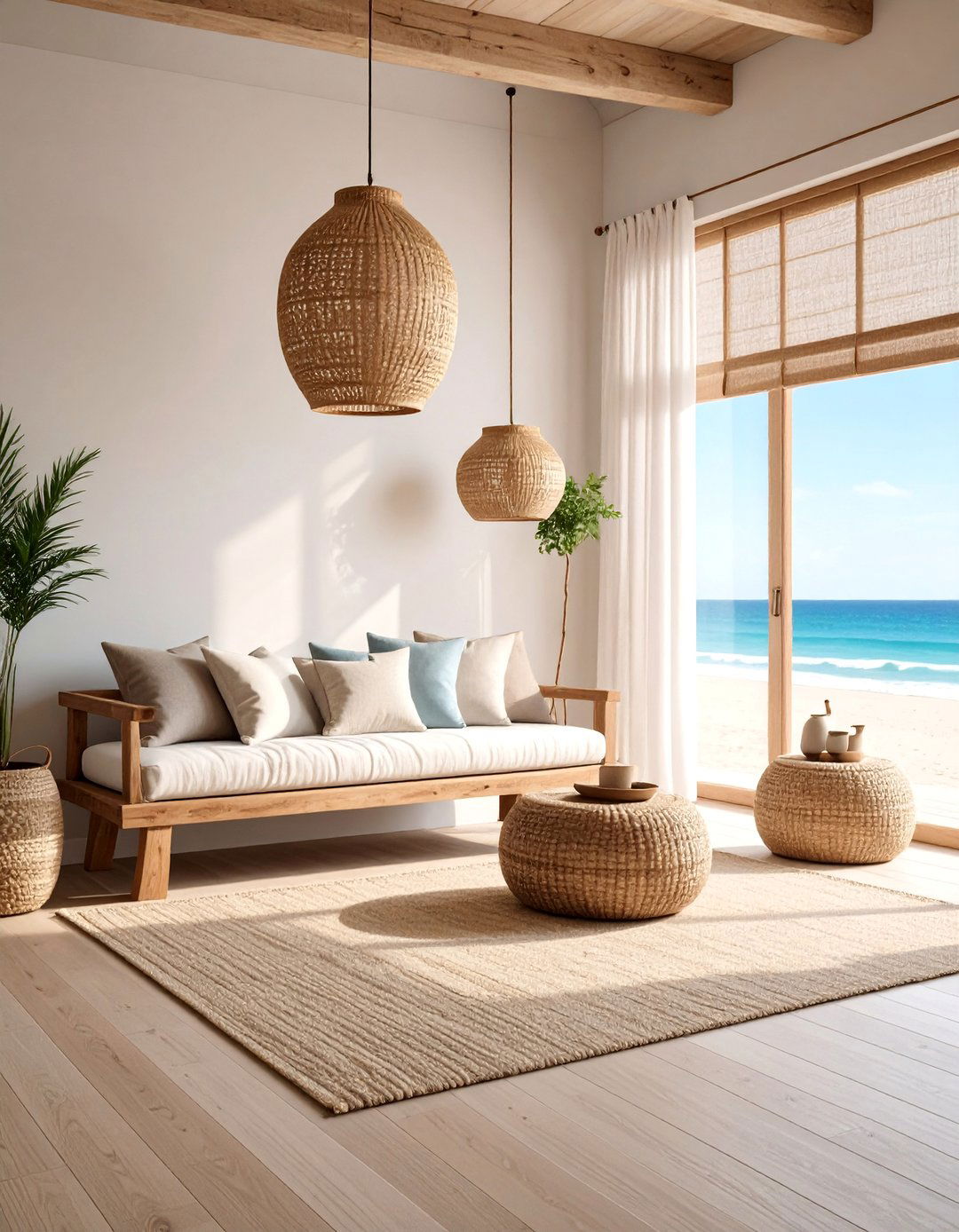
What could be more soothing than merging beach calm with Zen simplicity? Start with pale sand-colored micro-cement floors and whitewashed walls. A weathered driftwood beam doubles as a low bench fronting floor-to-ceiling windows dressed only in gauzy linen. Shell-aggregate side tables and stoneware vases echo shoreline textures. A large circular jute rug anchors seated meditation while whispering reminders of dunes. Gentle wave sounds play through hidden speakers, and a salt-crystal lamp glows softly at dusk, evoking sunset on the horizon without overt nautical clichés.
9. Urban Loft Zen Room with Concrete and Plants
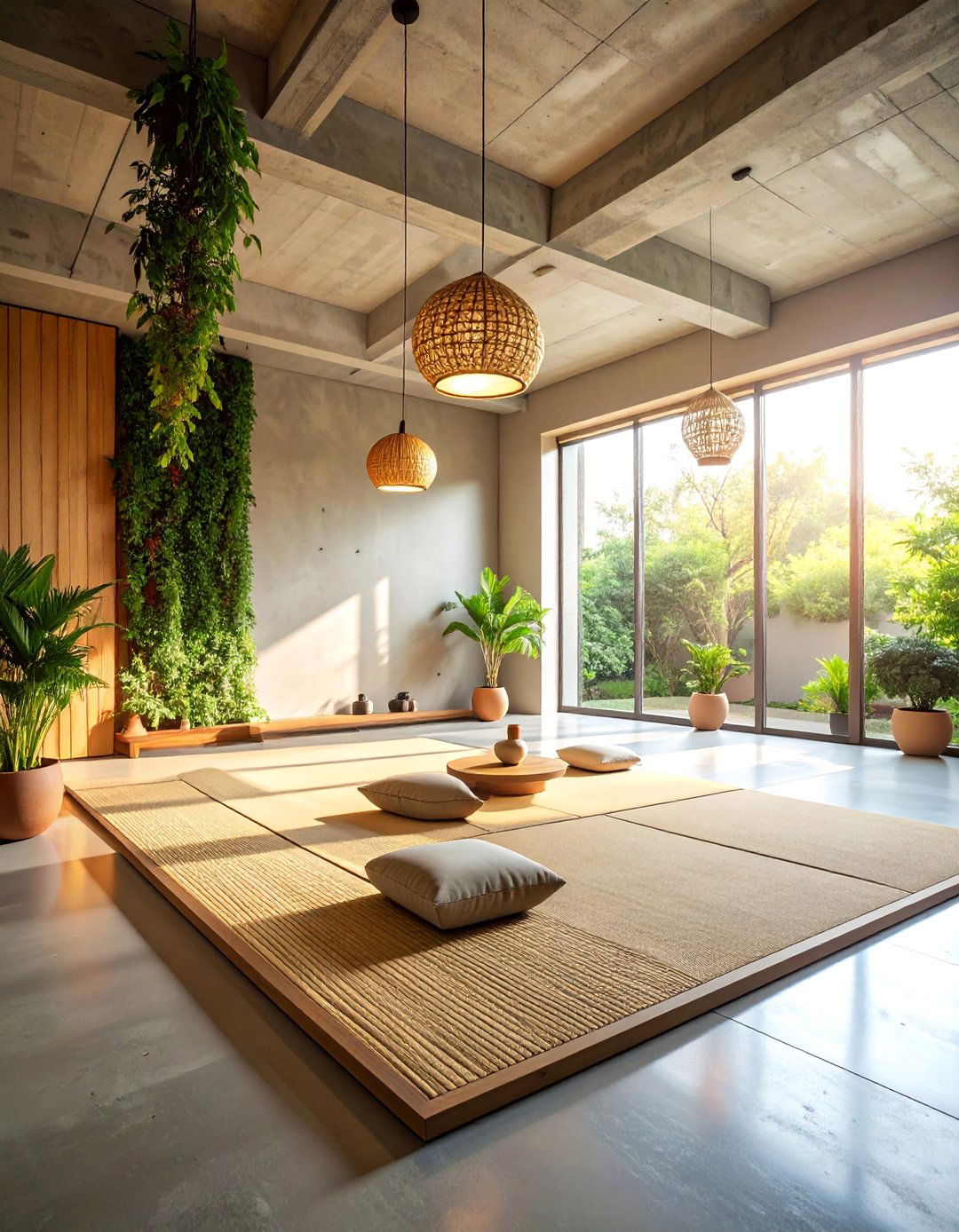
Despite industrial surroundings, tranquility thrives when rough concrete surfaces meet abundant foliage. Exposed ceiling ducts remain but are painted matte white to fade from view. A modular tatami-style platform defines rest space, while hanging planters cascade greenery at varying heights, softening hard edges. A single pendant with smoked-glass globe warms the atmosphere. Storage hides behind sliding plywood panels, keeping tech and clutter invisible. Aromatic cedar blocks tucked into vents infuse subtle forest scent, shifting the mood from city grit to inner stillness.
10. Zen Room Yoga Studio with Warm Lighting
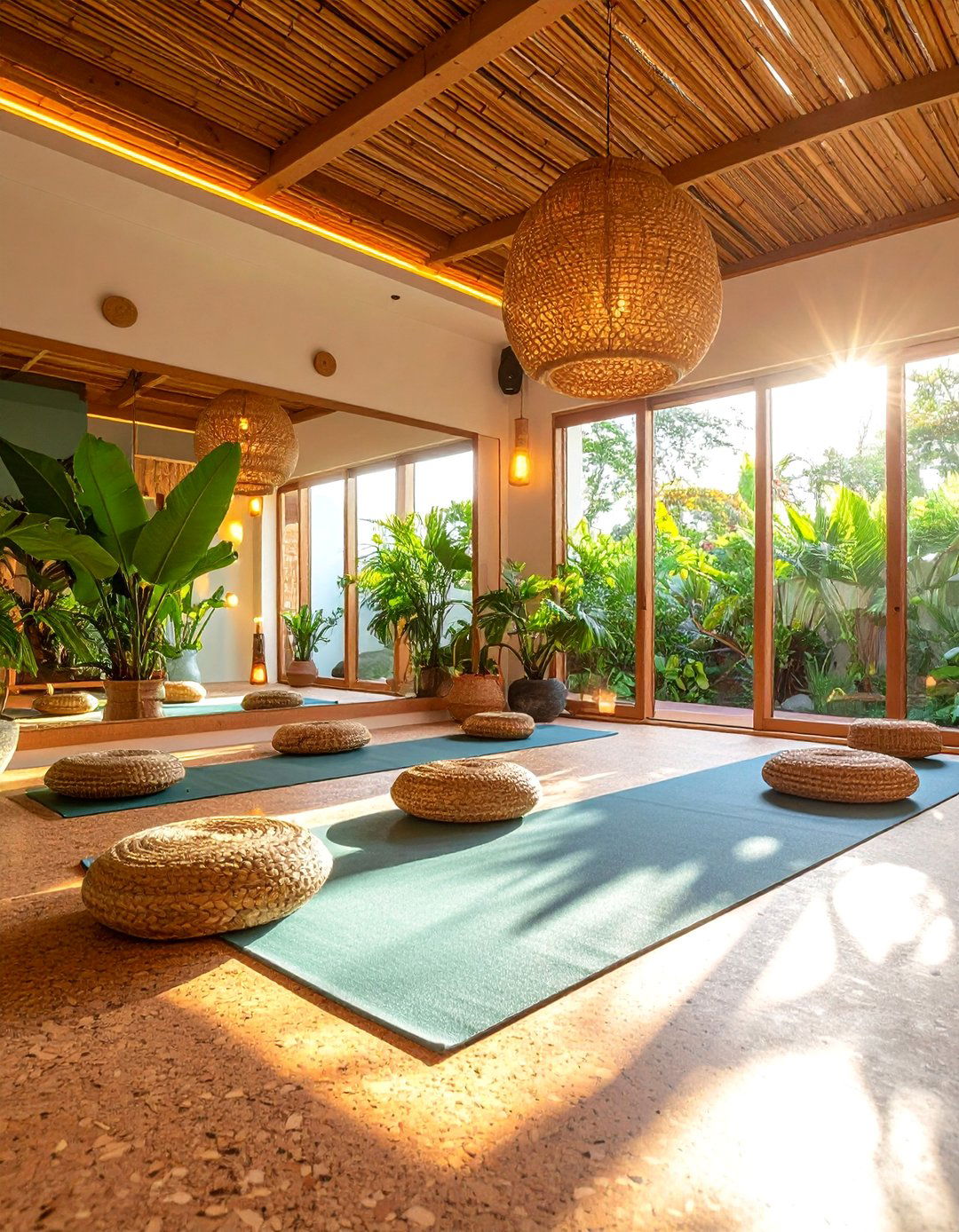
In, a spare 12-by-16-foot room transforms into a home yoga shala through cork flooring, full-mirror wall, and dimmable wall washers set to 2, 800 kelvin. Floating maple shelves store props — bolsters, straps, blocks — inside hand-woven seagrass baskets for tidy access. A folding shoji screen conceals equipment when not practicing, returning the room to general meditation use. Ceiling speakers play low-frequency Tibetan bowls to deepen savasana, while a Himalayan salt rock cluster acts as both accent and ionizer. The dual-purpose design supports active flow and passive stillness alike.
11. Zen Room Reading Alcove under Skylight

For book lovers, a recessed skylight centers this small reading haven, permitting natural light that tracks the day. Built-in, wrap-around oak bookshelves sit low, doubling as bench seating topped with muted cotton cushions. A single articulated brass sconce offers focused night illumination. Neutral plaster walls keep the eye on text, while a tatami mat underfoot encourages cross-legged posture. Hidden vents diffuse cedar aroma to invoke forest calm. By surrendering vertical space to daylight and books, the design marries intellectual stimulation with meditative quiet.
12. Zen Room with Acoustic Water Fountain Focus

Owing to water’s rhythmic lull, this concept features a freestanding slate fountain whose gentle cascade sets the auditory tone. Dark charcoal floors ground the space, contrasting with cream walls and a single low walnut bench. Pebble beds absorb splash while enhancing acoustics. Soft indirect LED strips frame the fountain niche, creating a focal glow. Minimal décor — perhaps a bonsai — enforces visual stillness, allowing sound and subtle scent from damp stone to become the main sensory anchor, ideal for breathing exercises and contemplative journaling.
13. Scandinavian Zen Room with Light Wood Accents

Bringing Nordic brightness to Zen calm, the scheme starts with white walls and bleached pine flooring. A pale birch daybed with rounded edges invites lounging, layered with stone-gray wool throws. Flat-front cabinetry hides necessities, and ribbed-glass closet doors diffuse window light. Sprigs of eucalyptus in a matte ceramic vase introduce gentle color. A paper globe pendant echoes Japanese lanterns, while maintaining Scandinavian simplicity. The room exemplifies functional serenity that feels fresh even in long winter months.
14. Zen Room Aromatherapy Cloud with Diffusers
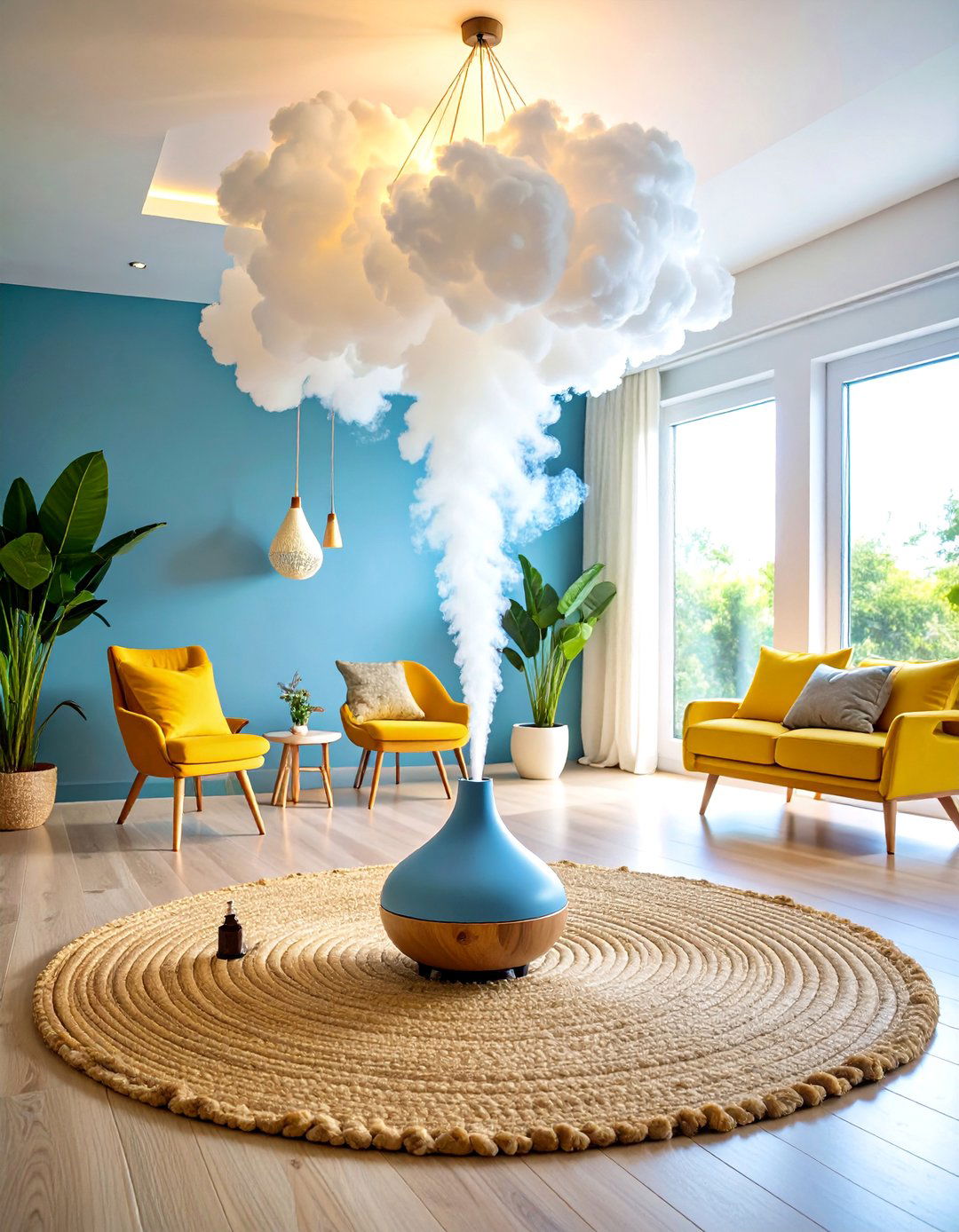
As research shows, scent deeply influences mood; therefore, this design elevates aromatherapy to a central feature. A ceiling-mounted ultrasonic diffuser releases visible mist illuminated by adjustable RGBW lights set to warm amber. Hardwood floors transition into a round hemp rug anchoring meditation cushions. Shelved essential oils — lavender, hinoki, yuzu — sit in a shallow niche, their labels facing inward to reduce visual chatter. Low background music syncs to diffuser cycles, guiding paced breathing. Storage is minimal; the sensory journey takes precedence over physical objects.
15. Zen Room for Digital Detox with Hidden Storage

Unlike tech-cluttered dens, this refuge hides every device behind ribbed-oak panels that slide shut at eye level. A charging drawer lined with felt ensures phones remain out of sight yet powered. Seating consists of bean-shaped floor poufs encouraging relaxed posture away from screens. Walls are painted mineral-based clay gray to absorb glare, while frosted clerestory windows provide daylight without external distractions. A small sand timer replaces electronic clocks, gently marking meditation intervals and reinforcing the detachment theme.
16. Zen Room with Floor-to-Ceiling Windows and Nature View

With panoramic glazing, nature becomes art. A simple platform daybed floats a foot from the glass, orienting gaze outward to trees or garden. Window frames are thin black aluminum, minimizing lines between interior and exterior. Underfoot, aromatic cedar planks extend onto an adjacent deck, visually merging zones. Long linen drapes on concealed tracks soften glare without blocking scenery. Furnishing remains sparse: a woven basket for blankets and a single low side table for tea, ensuring nothing competes with the live landscape.
17. Zen Room Children’s Calm Corner with Soft Textiles

To help kids self-regulate, transform a spare closet or nook into a cushion-lined retreat. Walls coated in non-toxic lime wash reduce echo, while floor-to-ceiling cotton drapes invite cocooning. Oversized plush floor pillows alternate muted sage and sandy beige, and a short book rack offers mindful storybooks. Battery-operated paper lanterns supply gentle light, safe for little hands. A felt wall panel displays interchangeable emotion cards so children can articulate feelings before quiet time, reinforcing emotional intelligence within soothing surroundings.
18. Zen Room Home Office with Clutter-Free Lines
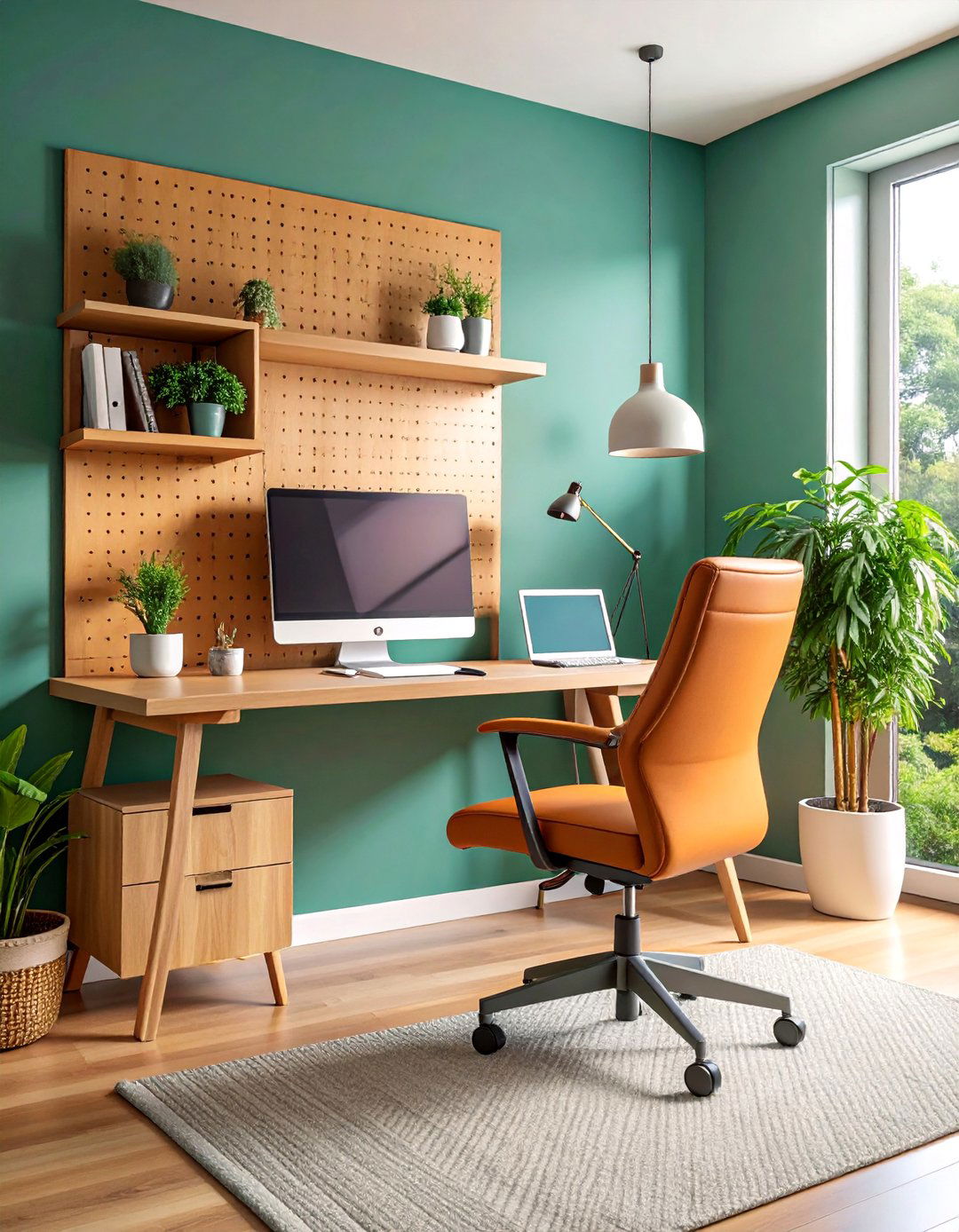
Incorporating productivity, this office employs a wall-mounted ash desk with no legs, keeping the floor visually open. A cushioned kneeling chair supports posture while respecting Zen ergonomics. Cable channels hide wires, and a pegboard finished in matching ash stores minimal supplies. Soft edge-lit shelves house a single bonsai and an hourglass. Frosted glass film on the window diffuses glare, protecting focus. When work ends, a sliding panel conceals the monitor, instantly transforming the space back into a meditation zone.
19. Zen Room Attic Retreat with Sloped Ceilings

After insulating rafters, paint ceilings warm white to amplify limited light. Low built-in drawers follow roof angles, turning awkward corners into storage. A tatami mat bed nestles under the peak, flanked by wall sconces directing glow upward, visually lifting the ceiling. Plywood beams remain exposed, celebrating honest structure. Small triangular windows gain shoji inserts that diffuse sunrise, creating a gentle wake-up. The intimate geometry promotes inward focus, perfect for journaling or breathwork before sleep.
20. Zen Room Shared Couple’s Sleeping Space

For partners craving calm, center a low platform bed accessible from three sides to encourage flow. Symmetrical bamboo night ledges hold matching stone lamps, fostering balance. Soft taupe walls blend seamlessly into a padded headboard alcove upholstered in ramie. Hidden drawers under the frame store linens, nixing bulky dressers. Layer linen, cotton, and silk bedding in tonal neutrals for tactile richness without visual chaos. A shared floor cushion at the foot invites joint meditation, reinforcing emotional connection nightly.
21. Zen Room Outdoor-Indoor Courtyard Transition

Shortly beyond sliding glass, a semi-covered courtyard melds with the interior via continuous slate pavers. Inside, a recessed seating pit with hemp cushions drops to patio level, blurring thresholds. A teak slat ceiling extends outdoors, visually elongating lines. Central focus is a shallow reflecting pool that starts indoors then flows beneath the glass into the courtyard, uniting spaces through water. At dusk, linear LED strips under coping stones illuminate the pool’s rim, creating a seamless luminous ribbon.
22. Zen Room Color Therapy Using Earthy Ochres

Studies on chromatherapy reveal muted ochres foster grounded calm. Paint three walls matte oat-straw while reserving one deep clay accent. Complement with woven sisal flooring and walnut-stained low shelving. Indirect uplights with dim amber bulbs emphasize warm tones. A thickly textured hemp throw and russet meditation pillow echo the palette. Minimal artwork — perhaps a single burnt-sienna brushstroke painting — caps the theme. The cohesive color story engages the parasympathetic nervous system, gently lowering heart rate during quiet practice.
23. Zen Room Sound Healing with Natural Instruments

For auditory therapy, dedicate wall space to hanging chimes, handpan, and rainsticks on discreet hooks. A cork floor dampens footfall, while a central round wool rug defines listening space. Diffuse light emanates from Himalayan salt sconces arranged in a circle, echoing the musical layout. Storage benches hide mallets and tuning forks when not in use. Practice begins by striking instruments sequentially, letting tones linger in air clarified by a whisper-quiet HEPA purifier, fostering deep vibrational calm.
24. Zen Room Monochrome Black-and-White Palette
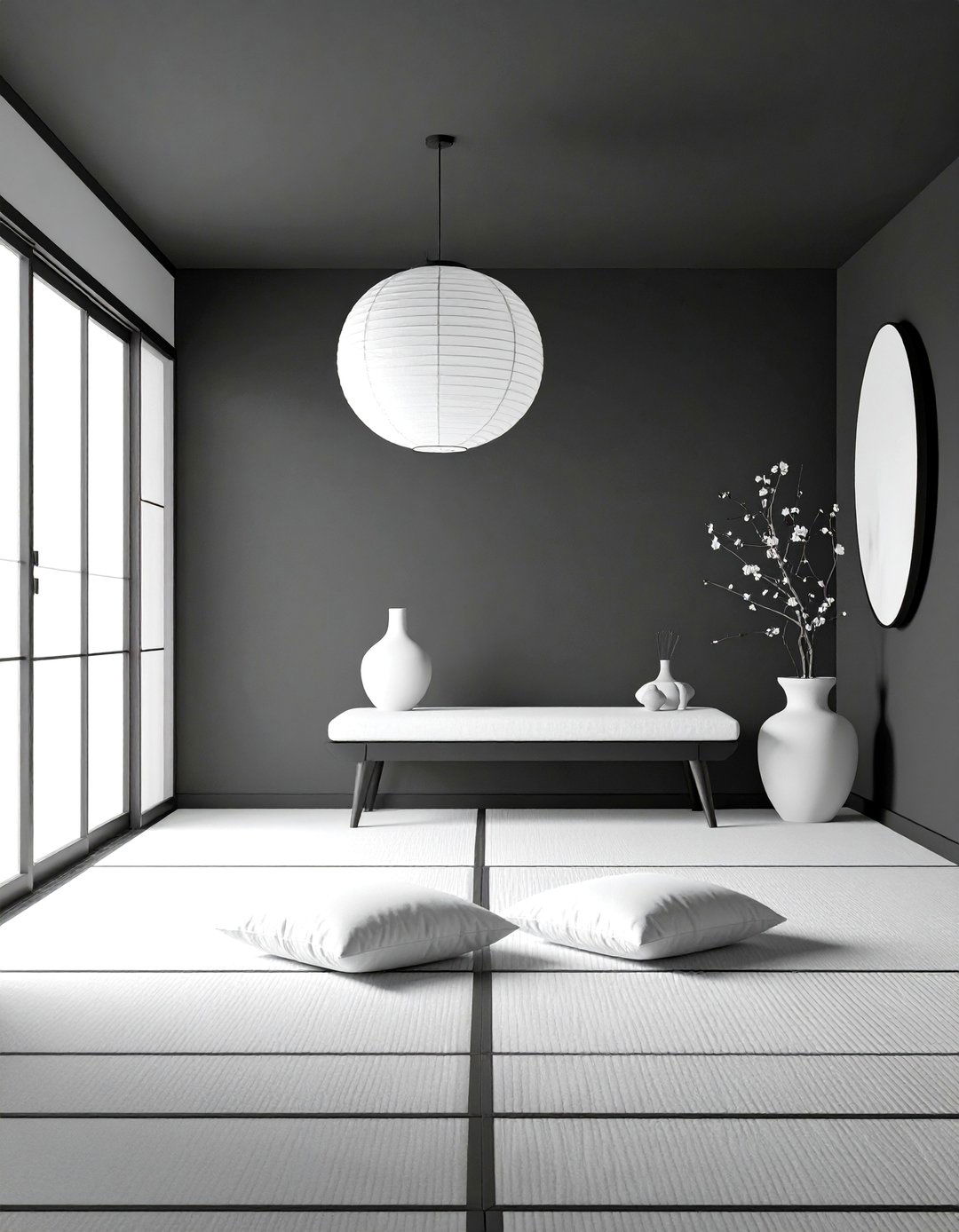
Although vibrant hues can distract, a high-contrast scheme feels surprisingly grounding when balanced. Matte charcoal walls pair with bleached beech flooring. A low futon in crisp white linen pops against darkness, mirrored by a white paper lantern overhead. Minimalist black steel shelving floats on brackets, holding only a few alabaster sculptures. Sheer white curtains temper daylight, and a single black vase with a solitary white orchid underscores intentional restraint. The stark palette encourages meditative focus by stripping away chromatic noise.
25. Zen Room Seasonal Flex Space with Modular Pieces

Finally, create adaptability by choosing lightweight, modular furniture — folding tatami mats, stackable futon blocks, collapsible cedar screens — allowing the room to shift from meditation to guest sleeping to yoga as seasons change. Neutral hemp floor cushions and layered gauze throws adjust for warmth. A peg rail system displays rotating seasonal decor: spring cherry branches, summer bamboo fans, autumn maple leaves, winter pine sprigs. Indirect cove lighting changes color temperature to mimic daylight shifts, nurturing circadian rhythm and ensuring relevance year-round.
Conclusion:
All things considered, cultivating serenity at home is less about square footage and more about purposeful choices. Whether through natural materials, sensory focal points, or flexible layouts, each of these Zen room ideas offers a complete, harmonious environment that supports mindfulness and restores balance.




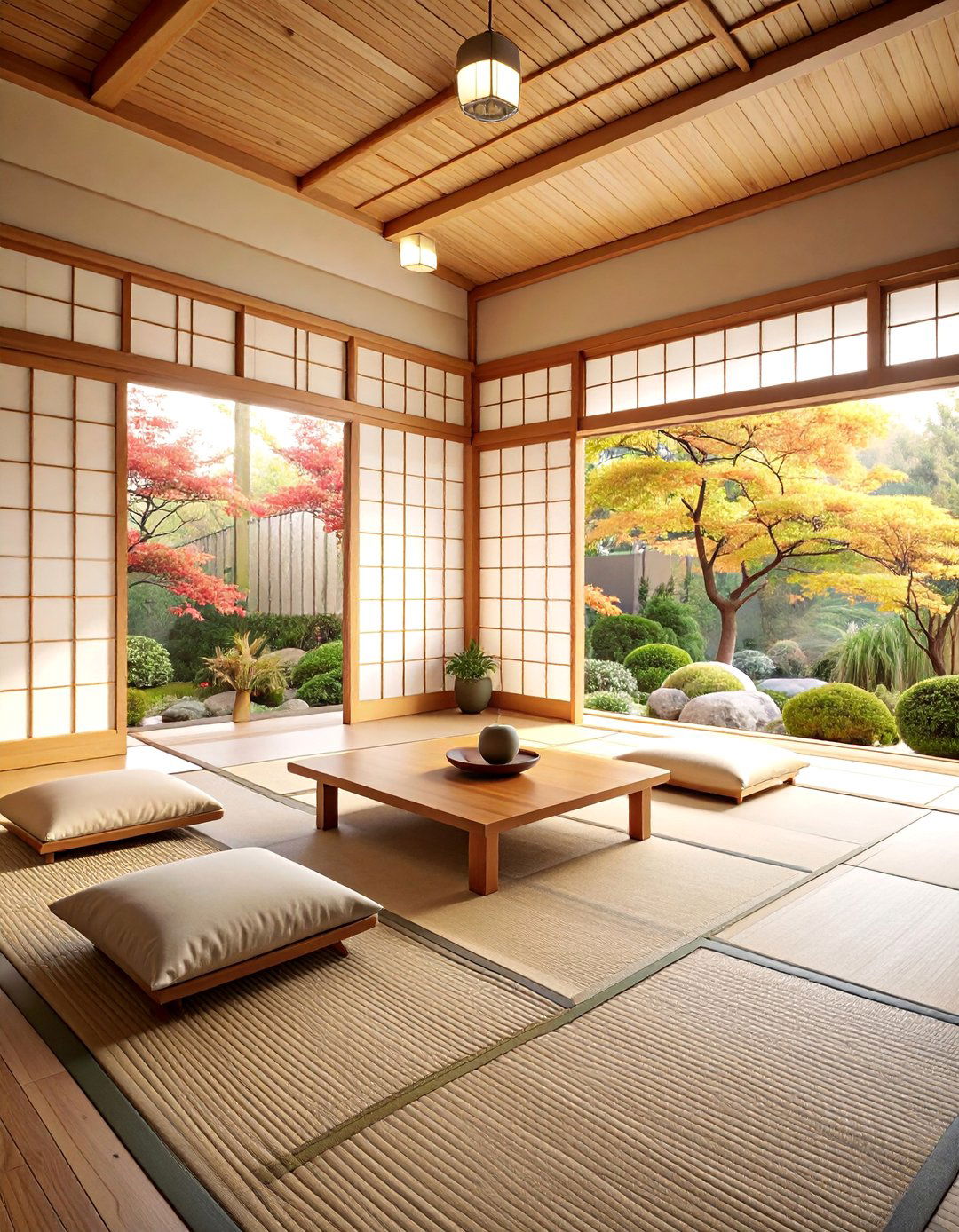
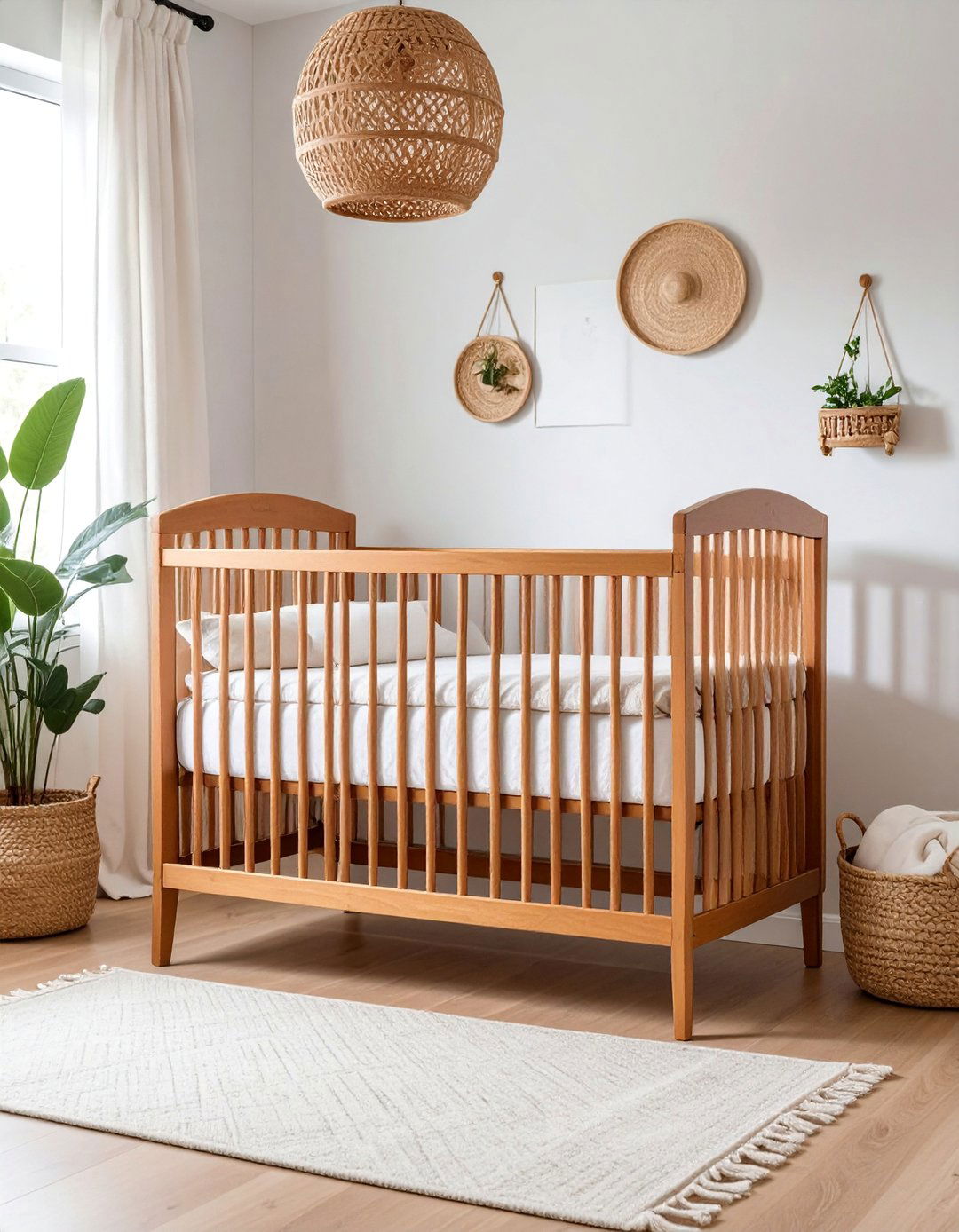

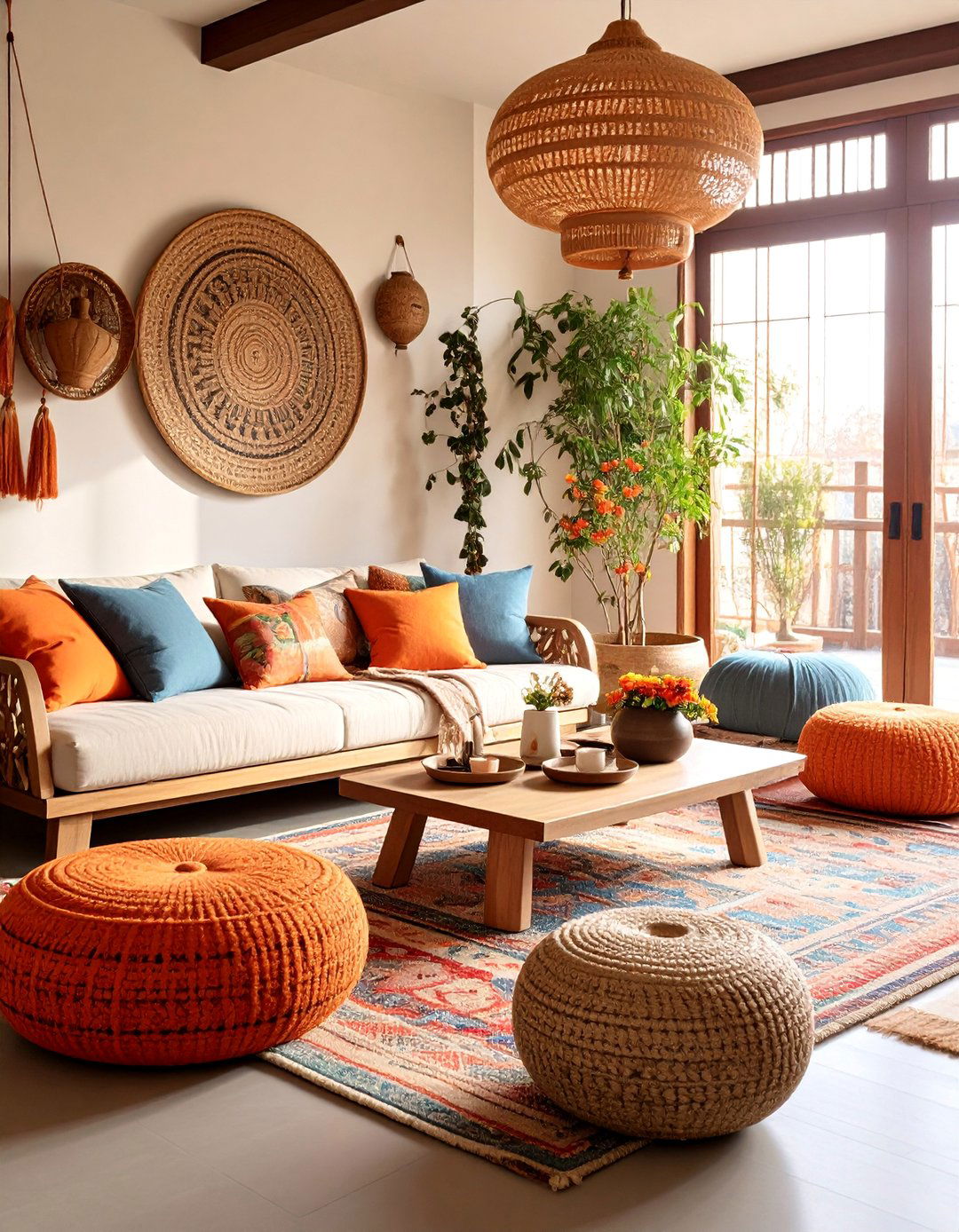

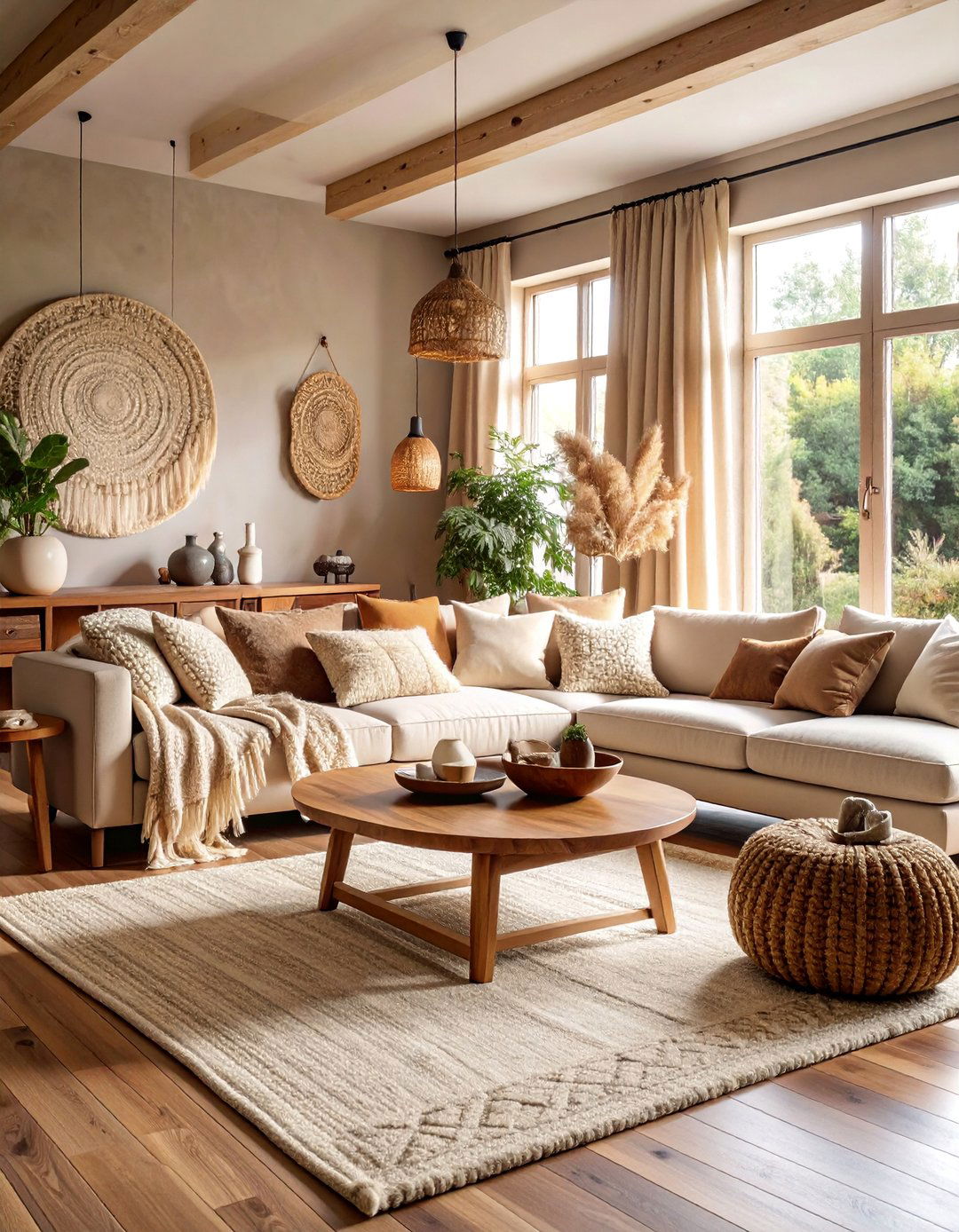


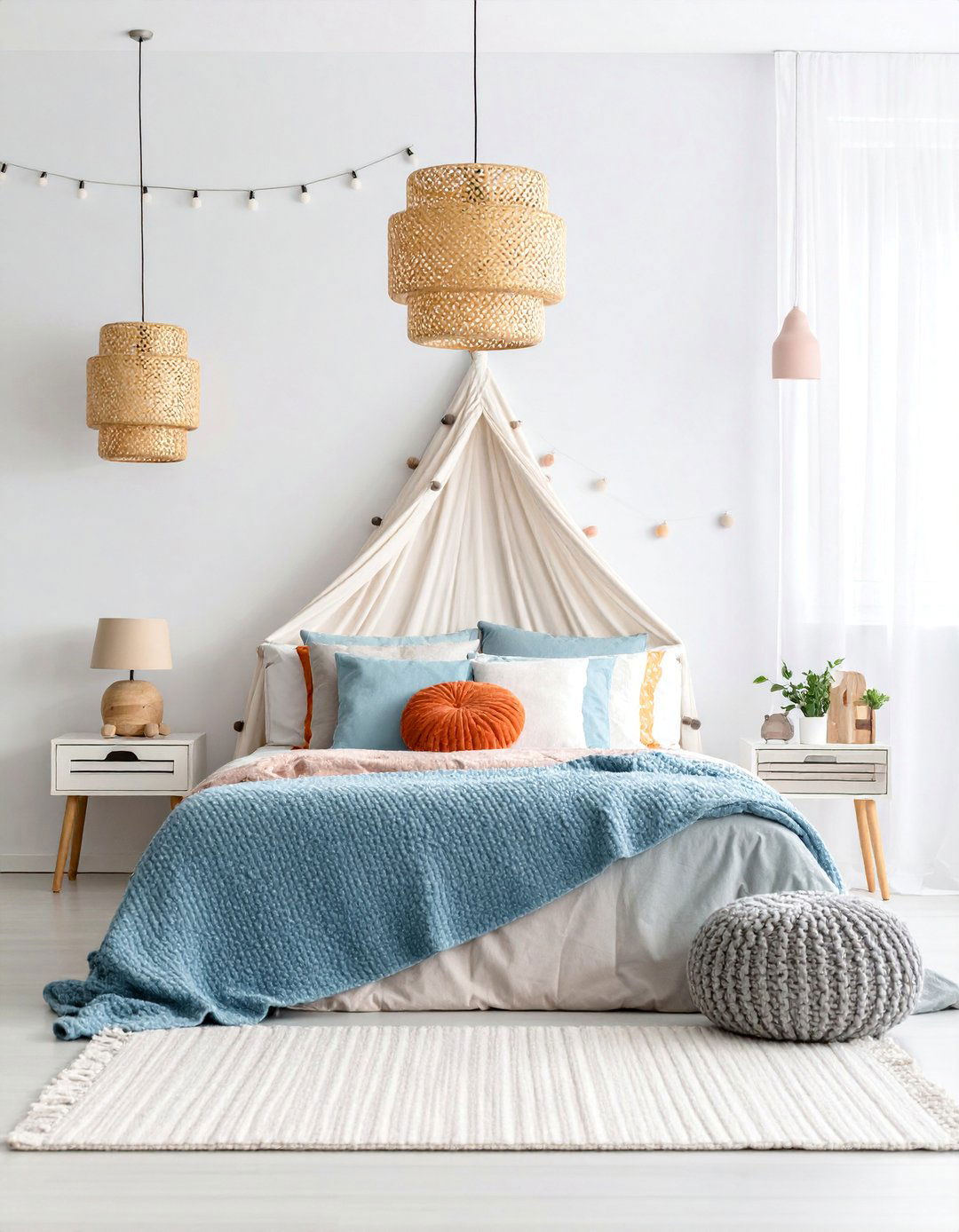
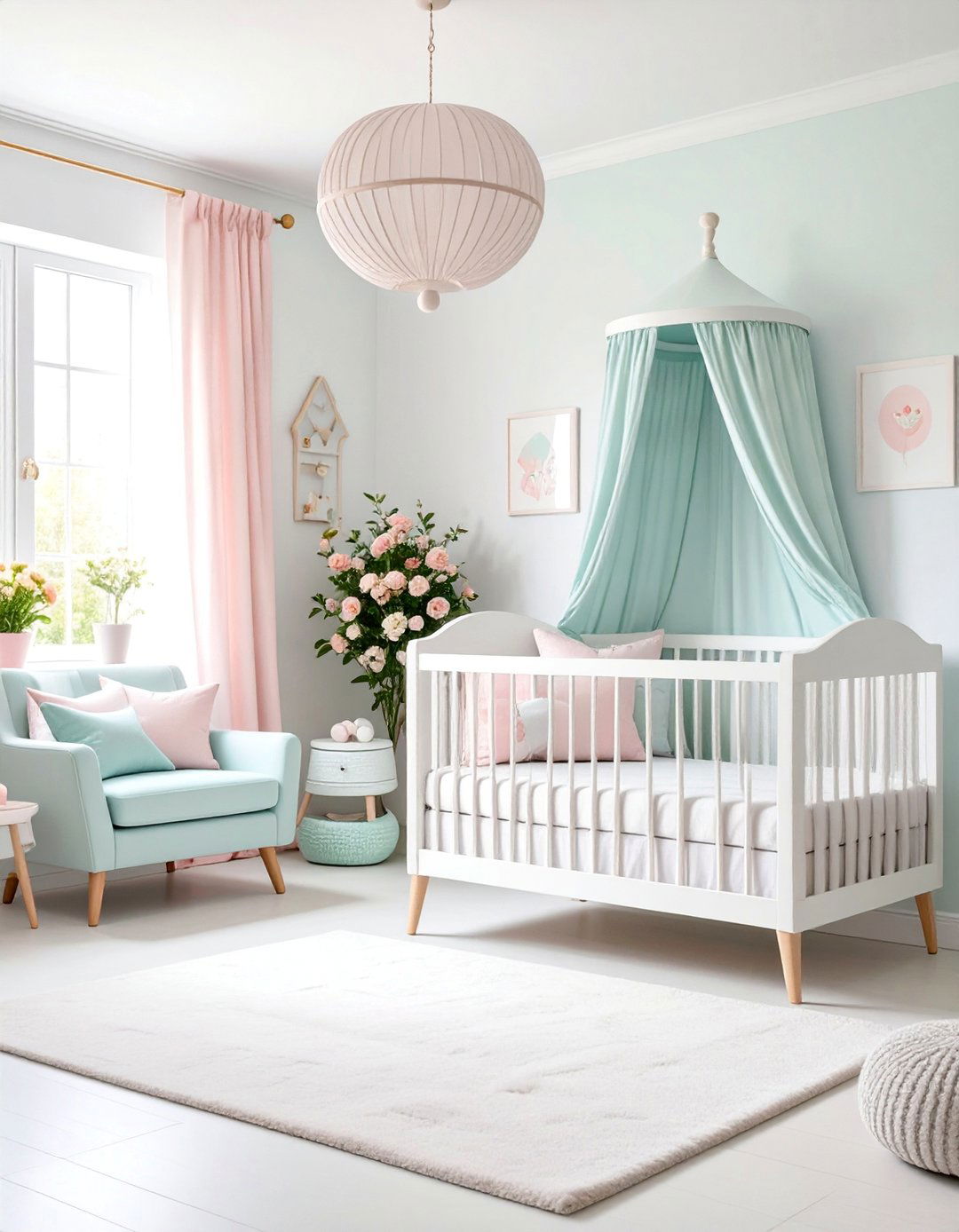
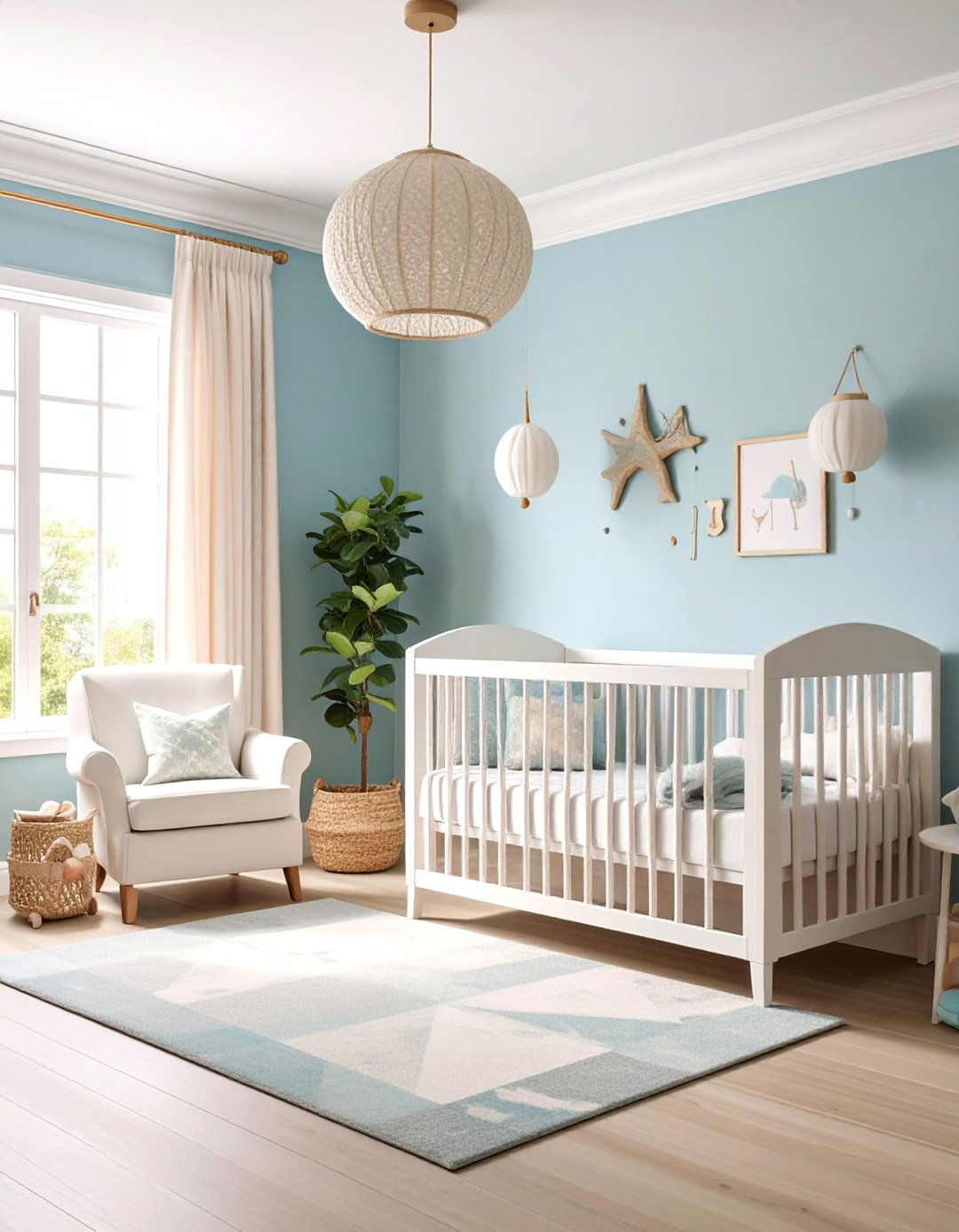
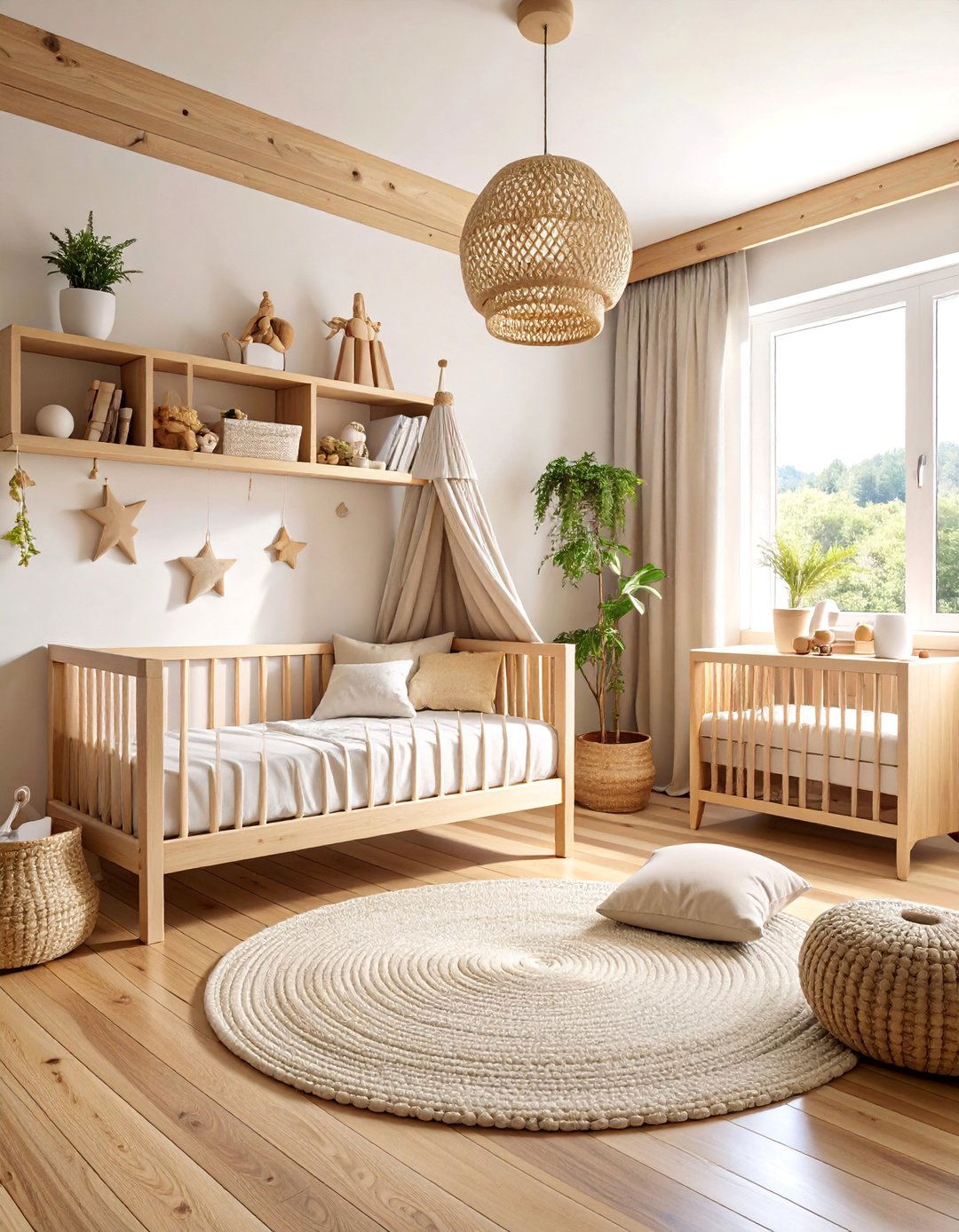
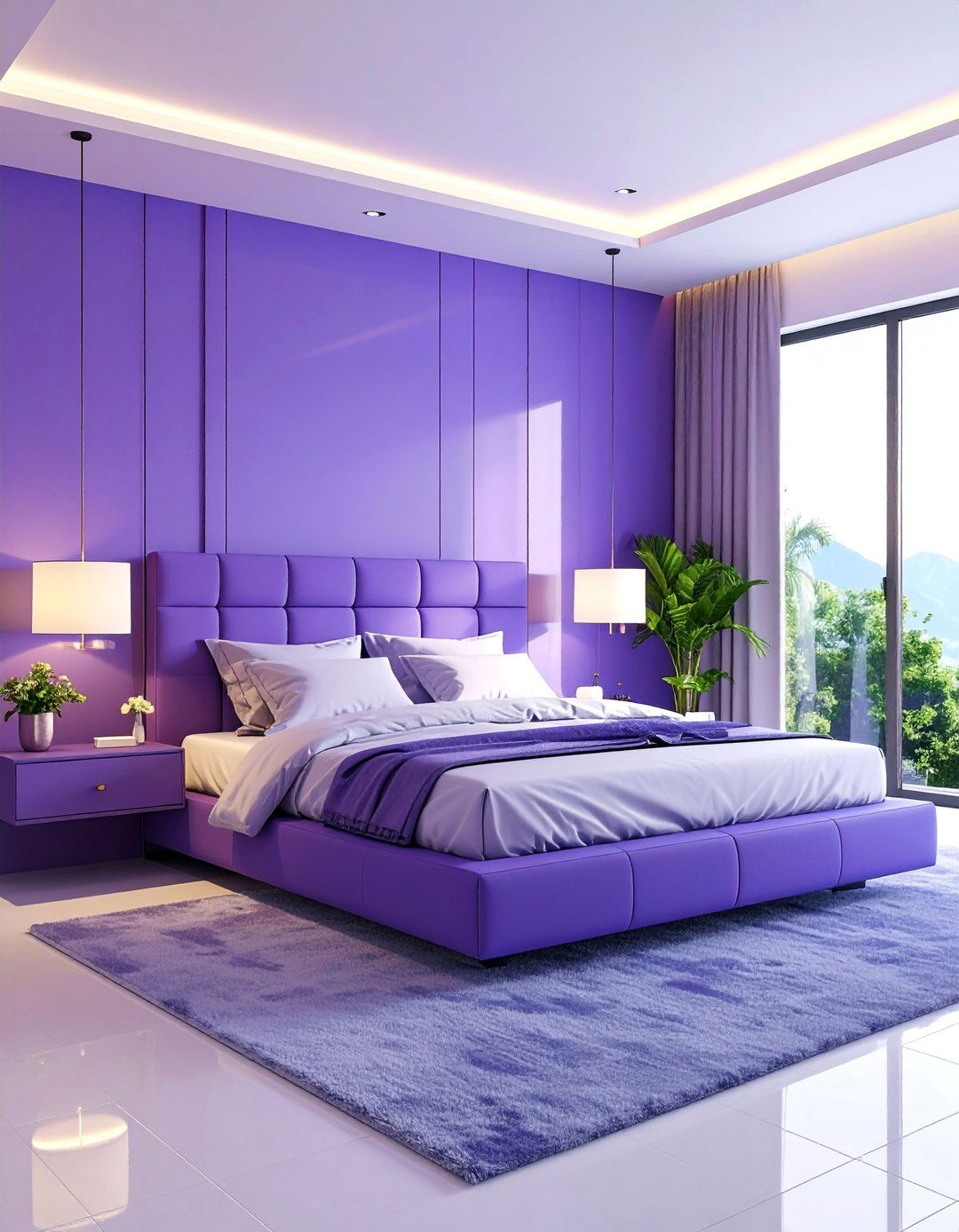
Leave a Reply